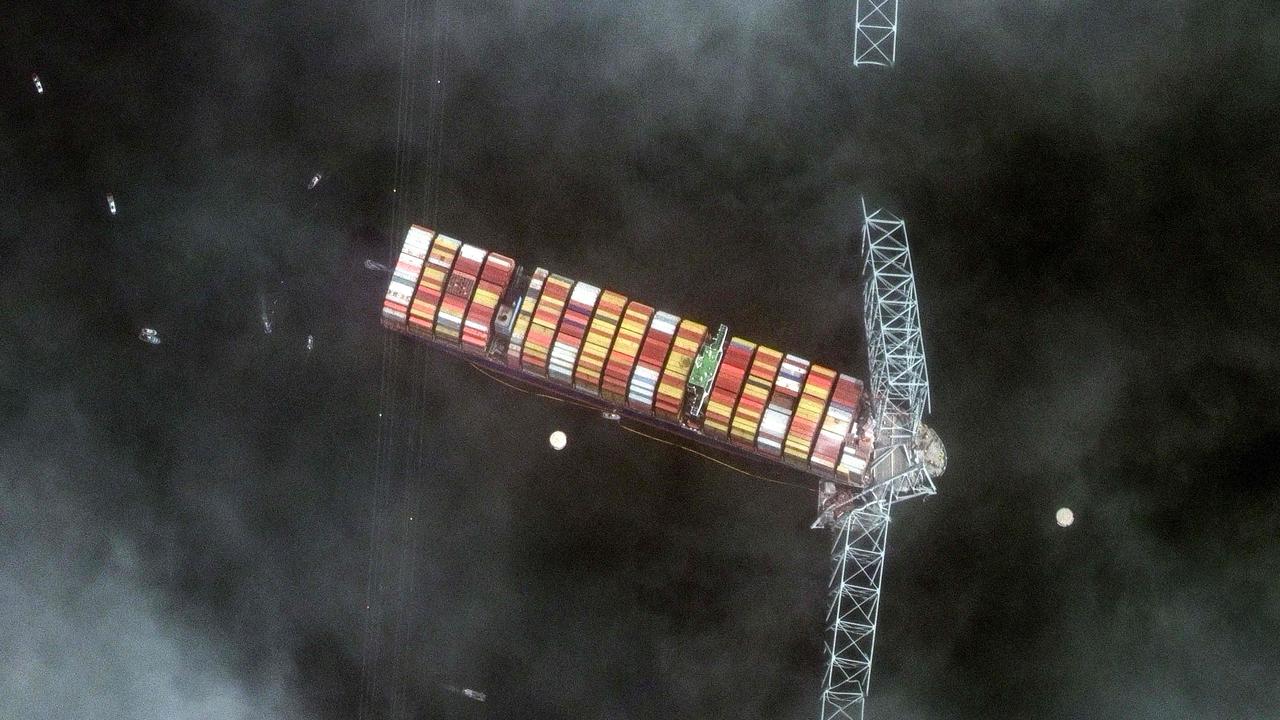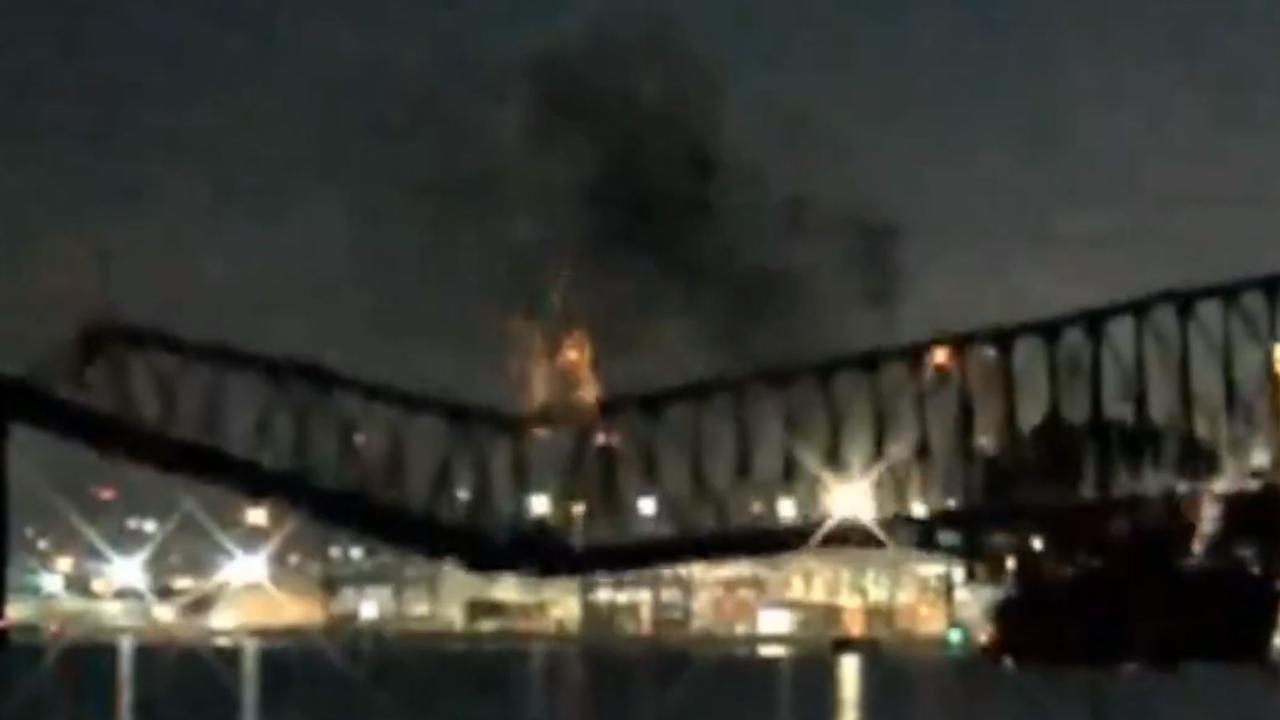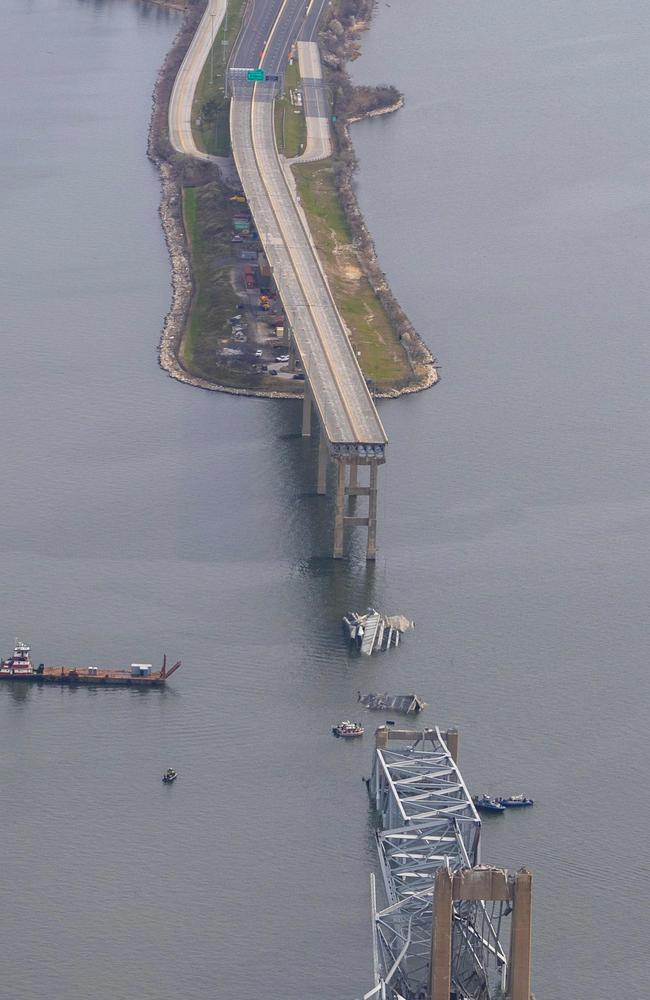Inside 251 seconds to save Baltimore bridge from collapse
The 22 crew of the container ship MV Dali had just 251 seconds to avert disaster before the 100,000-tonne vessel slammed into the US city of Baltimore’s main bridge.
ANALYSIS
The 22 crew of the container ship MV Dali had just 251 seconds to avert disaster before the 100,000-tonne vessel slammed into the US city of Baltimore’s main bridge.
It was never going to be an easy task.
The ship had just finished loading at the city’s container terminal. It had been guided into the shipping channel by two tugs. Two harbour pilots – experienced specialists whose job it is to guide vessels in and out of the confined waters – were aboard.
MV Dali is a relatively modern ship, completed in 2014 to modern “Neopanamax” (able to navigate the enlarged Panama Canal) standards.

Its single propeller, driven by 41,480kW (55,630 horsepower) diesel engines, had pushed the ship – and its cargo of up to 9971 shipping containers – up to 8.5 knots (15.7km/h).
“That’s about standard size these days,” says Texas A&M Maritime Academy deputy superintendent Allan Post. “Ship sizes have absolutely grown monstrous over the years. But 1000 feet (304m) is just about normal.”
Everything appeared normal.
The tugboats cast off and headed towards their next job. The MV Dali is nosing its way down the channel towards the North Atlantic.
Then, at 1:24:32 US EDT, a harbour webcam captures all the vessel’s lights suddenly going out.
“Let me be clear, the worst feeling ever on a ship is to lose power,” maritime logistics expert and Campbell University associate professor of history Sal Mercogliano explains. “Everything gets quiet. Silence is the enemy on a ship. That means everything has gone wrong.”
251 seconds to disaster
“What is causing the power outage on the vessel? Is it mechanical? Is it a computer? Is it fuel? We just don’t know. But the ship goes completely dark.”
Fully loaded, the 300m longship can weigh more than 116,000 tonnes when carrying a full cargo stacked in her hold and on the deck.
MV Dali was travelling at a speed necessary for water flow to give its rudder some effect. But the ship can move almost three times faster in the open ocean at 22kts (41km/h).
At 1.25:31 EDT – 59 seconds later – the lights come back on.
The ship immediately starts spewing black smoke from its stack.
This could be because the engine is straining to slow the ship. Or a possible sign of mechanical failure. It could also be the ship’s emergency diesel generator kicking in.
But that’s not the captain or harbour pilots’ immediate concern.
“Now, at this moment, there’s a big question about whether or not the ship has rudder control,” Mercogliano explains. “This is the key thing. If the ship does not have rudder control, then the ship is careening out of control. There’s nothing you can do.”
But the Dali has already begun to drift off course.
“Remember, this is a vessel that is about 100,000 tons,” he adds. “It will have a lot of momentum. And if they had lost power, the rudder would not be answering. So wherever that rudder was, even if the rudder was dead centre, it’s not providing any manoeuvrability because you have torque from the propeller. The propeller is going to want to twist the ship.”
And if the MV Dali had thrown its propeller into full reverse, the rudder would no longer have any effect.

Whatever the cause, it is time to raise the alarm.
“Hopefully, they’re calling out issues on Channel 16 (International Distress Channel) And the other hailing channels,” he adds. “They will have portable radios, so they don’t need the ship’s radio.”
Then, after just 66 seconds, the MV Dali’s lights go out again.
184 seconds to disaster
A second power failure seems apparent from the harbour camera at 1:26.37 EDT.
But the ship’s swing out of the channel is becoming more apparent.
Commercial shipping traffic monitoring site marinetraffic.com shows the Dali appears to begin to slow at this point to about 7.6 knots (14.1km/h).
“We know she drops her port anchor. We just don’t know when,” says Mercogliano.
It’s also standard procedure to have crew ready on the bow of a ship to drop anchor as it leaves harbour. Helicopter footage appears to show one of the Dali’s anchors had been deployed.
But these anchors are designed to hold stationary ships in position. Not to bring 100,000 tonnes moving at 15km/h to a dead stop within a kilometre.
The bridge is just a few hundred metres away.
And the Dali’s funnel is still belching black smoke.

Without power, the ship’s diesel engine has no pumps feeding it fuel, air or lubrication oil. An emergency generator can power enough lights and ventilation for engineers to enter the engine room to assess its problems. But the process of reconnecting the lines through the main switchboard takes time.
It takes just 32 seconds for them to get the light back on again, at 1:27.09.
The crew had just 94 seconds left.
90 seconds to disaster
By now, though, the ship is well out of the channel and headed for the bridge.
The ship’s master (captain) remains responsible for the ship’s safe handling at all times, says Post. And the expert harbour pilots would normally only be advising on local navigational issues, such as the ideal course and speed under varying tide and wind conditions.
A US Coast Guard report obtained by the Baltimore Sun quotes pilots aboard the Dali saying that the bridge (ship’s command centre) team observed “power issues, multiple alarms on the bridge, and the loss of propulsion prior to the incident”.
Baltimore Police say they received a Mayday call (declaration of emergency) from the MV Dali just 90 seconds before the disaster.
“I need one of you guys on the south side, one of you guys on the north side, hold all traffic on the Key Bridge,” the “all units” police call is heard to say. “There’s a ship approaching that just lost their steering so until we get that under control, we’ve got to stop all traffic.”
The Dali appears to have regained some rudder control at this point. The ship begins to swing back towards the deeper water and tallest spans of the Francis Scott Key Bridge. But it’s already too late to haul its 100,000 tonnes around fast enough.
“My initial assumption is that I think it’s going to come down to an electrical fault on the ship that was just terrible timing,” concludes Post.

“Just minutes before the bridge, there was a total blackout on the ship, meaning that the ship lost engine power and electrical power, it was a complete blackout,” according to Clay Diamond, executive director and general counsel of the American Pilots Association.
He says the harbour pilot ordered the MV Dali to drop its anchor and shift its rudder “hard to port” in an effort to drive the ship aground ahead of the bridge.
“It happened so quickly and with so little lead time … neither one of those maneuvers were enough,” Diamond adds.
At 1:28.43 EDT, the Dali strikes the bridge support.
The Francis Scott Key Bridge immediately collapsed.
The whole bridge just fell down. Start, start whoever … everybody,” one shocked officer is heard saying. “The whole bridge just collapsed.”
Two people have been rescued from the water. Six others remain missing.
Aftermath
The 396m main steel span of the Francois Scott Key Bridge started construction in 1972.
It was an era before 100,000-tonne container ships existed.
But it was never designed to survive impact from any ship.
Only those constructed after the Sunshine Skyway Bridge in Tampa Bay collapsed in 1980 have such requirements. It was hit by the 183m long freighter MV Summit Venture, killing 35 people after six cars, a truck and a Greyhound bus fell into the sea.

When the MV Dali struck one of the vertical columns supporting the Francois Scott Key Bridge’s main span, US bridge engineer Matt Dursh says it triggered a cascading structural failure.
“This bridge was going to fail from this event. It simply was not designed for an equivalent static force that is well over 3 million pounds (1.4 million kg).
“The whole truss fell because this is a continuous bridge. This means that the 3-span unit behaves as one. If one span fails, the maximum dead loads redistributes.”
Modern bridges, he adds, are built with barriers of sand and rock around their support columns to stop a ship before it hits the structure itself. But they are also built with deeper foundations, greater flexibility and more diverse load distribution.
Meanwhile, the wrecked bridge remains the focus of rescue and recovery efforts.
“All the ships that are now in Baltimore are trapped in Baltimore, they cannot get out,” adds Mercogliano. “That means that vessels that are in there are going to have to wait for the Key Bridge to be cleared. And obviously, that’s gonna be a long prospect.”
Other container ships and bulk carriers had been sitting in the bay, waiting for their turn to access the port facilities. These will now have to find other ports with spare capacity before they can unload.
This is already causing shipping companies to race to secure available container ship berths across the United States years in advance.
Like passenger jets, “slots” – when terminal space is available with enough time for a turnaround – are a limited commodity.
Dursh adds that replacing the Francis Scott Key Bridge will take up to a decade. And much of that process will involve interrupting the flow of shipping to Baltimore’s port.
“Officials will need to ask … do they fully replace the bridge in full, or attempt to reopen sooner with only the main span?” he concludes.
Jamie Seidel is a freelance writer | @JamieSeidel






